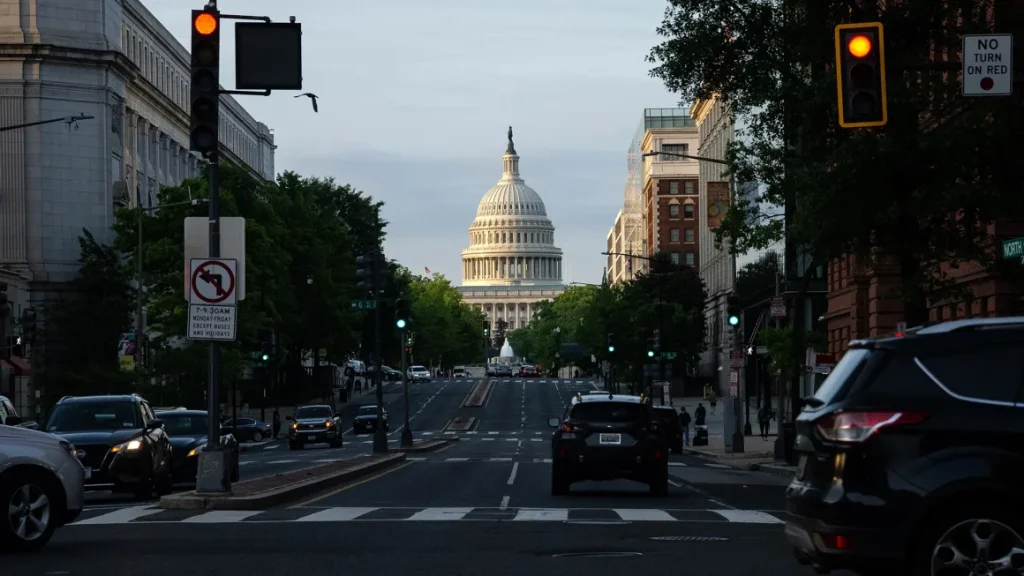What the House GOP is proposing in its first draft of Trump’s sweeping tax and spending cuts package

House Republicans have started releasing some details about the most consequential and controversial parts of their sweeping tax and spending cuts package, otherwise known as President Donald Trump’s “big, beautiful bill.”
The House Energy and Commerce Committee on Sunday unveiled the initial text of its contentious proposal to slash spending on Medicaid, though the measures did not slice as deeply into program as some conservative members would like. However, the plan isn’t finalized and could still change before the committee votes on it, which is expected later this week.
The House Ways and Means Committee on Friday provided an early glimpse into some of the tax changes — including a boost to the popular child tax credit — it hopes to include in the package. But GOP lawmakers have yet to unveil their plans to address the cap on the state and local tax deduction, which moderates are adamant about raising, and the bevy of tax cuts Trump promised during his 2024 campaign, including exempting tips from taxation.
The overall package aims to extend the GOP’s 2017 Tax Cuts and Jobs Act, as well as to fulfill several of Trump’s campaign promises. To help offset these tax reductions, which would total trillions of dollars over a decade, the House is also looking for at least $1.5 trillion in spending cuts.
Republicans are also signaling they will make good on other Trump campaign promises, such as significant investments in staffing at the US southern border, new systems to discourage immigration into the US and a gigantic new missile defense shield. Then there are other longtime GOP policy goals, such as an overhaul of the nation’s outdated air traffic system, new fees targeting electric cars and a pivot away from federal student loans.
Eleven House committees are working on pieces of the larger bill, which will then be assembled into the package. Speaker Mike Johnson hopes to vote on the legislation before Memorial Day — an ambitious deadline. The Senate, however, has different ideas of what should be in the package. The chamber also has stricter rules of what can be included since congressional Republicans are pushing the legislation through using the budget reconciliation process so they don’t need Democratic support in the Senate.
Here’s what we know about the initial plans that some House committees have proposed for the legislative package:
Medicaid work requirements
For the first time in Medicaid’s 60-year history, certain recipients ages 19 to 64 would be required to work at least 80 hours a month to retain their benefits, according to an initial version of the Energy and Commerce Committee’s plan. They could also meet the controversial mandate by engaging in community service, attending school or participating in a work program.
The requirement would not apply to parents, pregnant women, medically frail individuals and those with substance-abuse disorders, among others.
Republicans have long sought to add work requirements to Medicaid, which provides health insurance to low-income Americans. The first Trump administration granted waivers to several states to implement such a mandate, but the efforts were halted by federal courts.
The plan also mandates states to check Medicaid expansion recipients’ eligibility every six months, instead of annually, and to require that certain low-income adults covered under Medicaid expansion pay for a portion of their care. Recipients would also have to prove they have US citizenship or legal immigration status.
In addition, the plan would penalize states that have expanded Medicaid and that provide Medicaid coverage to undocumented immigrants using state funds. These states would see a 10% reduction in their federal matching funds for the expansion population. Several states, including California, New York, Utah and Illinois, cover undocumented children, adults or both in state health plans.
Clean energy program funding
The Energy and Commerce Committee is also calling to rescind funding from many of the clean energy programs passed under the Inflation Reduction Act, which Democrats pushed through Congress in 2022 when they had the majority in both chambers.
Larger child tax credit
The child tax credit would rise to $2,500, up from $2,000, per child between 2025 and 2028, under the initial, bare-bones version of the tax plan the Ways and Means Committee released Friday.
Also, the measure would require that parents, in addition to the child, have Social Security numbers. Currently, parents can claim the credit if they have individual taxpayer identification numbers, which some noncitizens who are not eligible for Social Security numbers use to file federal taxes.
The plan would temporarily boost the standard deduction by $1,000 for single filers and $2,000 for married couples.
And it includes some measures that would benefit wealthy Americans. It would make permanent the larger estate tax exemption, which would be set at $15 million per person for 2026 and would be indexed to inflation thereafter.
Plus, it would make permanent a special deduction for the owners of certain pass-through entities who pay their business taxes on their individual tax returns. It would beef up that deduction to 22%, up from 20%. These so-called pass-through businesses include partnerships, such as those formed by lawyers, doctors or investors.
Here’s what we know about what other House committees have already approved:
Federal student loans
The Education and Workforce Committee’s plan would dramatically restructure the way students can borrow from the federal government for college, as well as make big changes to the popular Pell grant program. It is seeking to find about $330 billion worth of savings by limiting the federal role in the student borrowing process.
The measure would cap the total amount of federal aid a student can receive annually at the “median cost of college” and end economic hardship and unemployment deferments. Plus, it would bar loan servicers from temporarily suspending student loan payments for more than nine months over a two-year period.
The changes also include terminating the subsidized loan program for undergraduate students and the Graduate PLUS loan program for new borrowers, with a three-year exception for students with such loans. The plan would amend the maximum annual and aggregate loan limits for unsubsidized loans, as well as require undergraduate students to exhaust their unsubsidized loan options before their parents can take out Parent PLUS loans.
In addition, the measure would terminate all income-contingent repayment plans — including former President Joe Biden’s SAVE plan, which has been blocked in federal court. Instead, borrowers would have a choice of a standard repayment plan or a repayment assistance plan based on borrowers’ income.
The committee is proposing alterations to the Pell grant program, including requiring students attend school at least half time and increasing the number of credit hours needed for full-time enrollment. But it would expand eligibility for such grants for students enrolled in short-term workforce programs.
And the measure would create “skin-in-the-game accountability” for colleges participating in the Direct Loan program by requiring them to reimburse the Department of Education for a portion of loans that aren’t fully repaid.
It would also establish a “Promise” program to provide colleges with performance-based grants of up to $5,000 per federal student aid recipient. The colleges must provide students with a guaranteed maximum total price for their program of study based on income and financial needs categories. The formula would reward institutions for strong earnings outcomes, low tuition, and enrollment and graduation of low-income students.
Immigration fees and ICE funds
Immigrants applying for asylum and work authorization, as well as those applying for humanitarian parole and temporary protected status, would have to pay new or higher fees, under the House Judiciary Committee’s plan.
Asylum seekers and parolees would have to pay $1,000 to apply and $550 for an initial work permit, for instance. Plus, sponsors of unaccompanied children would have to pay up to $3,500.
The measure also provides $45 billion to build new immigration detention facilities, including family detention centers, to allow the detention of at least 100,000 people a day, on average. It supports hiring 10,000 more Immigration and Customs Enforcement officers, including money for retention and signing bonuses for the agents, and provides funding for 1 million annual deportations through ground and air transportation.
And it provides $1.3 billion to hire immigration judges and support staff, as well as to expand courtroom capacity.
Border security
The House Homeland Security Committee is proposing tens of billions of dollars to bolster border security, including $46.5 billion to expand and modernize the border barrier system. Planned investments include the completion of 700 miles of primary wall, the construction of 900 miles of river barriers, and the replacement of 141 miles of vehicle and pedestrian barriers.
The measure would also provide $5 billion to acquire, construct or improve Customs and Border Protection facilities. Plus, it would funnel $4.1 billion for the agency to hire and train 3,000 new Border Patrol agents, 5,000 new Office of Field Operations customs officers, 200 new Air and Marine Operations agents, 290 support staff, and eligible retired agents and officers. It would also invest $2 billion in annual retention bonuses and signing incentives.
It would provide nearly $1.1 billion to strengthen technology to detect and disrupt the smuggling of illegal drugs and people into the US, and $2.7 billion for border surveillance technology, including tunnel detection capability and unmanned aircraft systems.
And the plan includes $1 billion for security and planning for the 2028 Olympics in Los Angeles, as well as $625 million for the 2026 FIFA World Cup, which will be hosted by the US, Canada and Mexico. It would also provide $300 million for the Federal Emergency Management Agency for the reimbursement of extra law enforcement costs for protecting presidential residences.
Federal employee retirement benefits
The plan approved by Republicans on the House Oversight Committee, which is tasked with cutting at least $50 billion in spending, would require federal employees to contribute more to their pensions and make other changes to their retirement benefits.
The most significant measure would be raising the Federal Employees Retirement System contribution rate for many current civilian and postal employees to 4.4% of their salary. Those hired prior to 2014 generally contribute either 0.8% or 3.1%, while more recent hires generally already contribute 4.4%.
For new, younger retirees, the plan would also eliminate the additional retirement annuity payment they would receive until they are eligible for Social Security benefits. And it would base retirees’ pension payments on their average highest five earning years, instead of highest three years, as well as reduce retirement system contributions for employees who agree to serve “at will,” giving them fewer job protections.
Plus, the plan would institute a fee for employees’ appeals to the Merit Systems Protection Board, which would be refunded to them if they win their appeal. And it would require a comprehensive audit of workers’ dependents enrolled in the Federal Employees Health Benefits program, including the verification of marriage and birth certificates.
Electric and hybrid vehicle fees
Under the House Transportation Committee’s plan, electric vehicles would have to pay an annual registration fee of $250 and hybrid vehicles would be assessed an annual fee of $100. The funds would be deposited into the Highway Trust Fund.
But a proposal to levy a $20 annual tax on gas vehicles was dropped, after it faced swift pushback from conservatives.
The committee’s plan would also eliminate seven green programs authorized by the Democrats’ 2022 Inflation Reduction Act, including the Low-Carbon Transportation Materials Grants Program and the Federal Aviation Administration’s Alternative Fuel and Low-Emission Aviation Technology Program.
The committee is tasked with providing $10 billion in savings.
Air traffic control
The House Transportation Committee would appropriate $12.5 billion for the modernization of the nation’s air traffic control system. The funds would begin replacing outdated technology and enhance the hiring of air traffic controllers.
Financial company oversight
The plan proposed by the House Financial Services Committee would limit the embattled Consumer Financial Protection Bureau’s authority to draw funds from the Federal Reserve. Also, it would essentially eliminate the Public Company Accounting Oversight Board, which was established by Congress to oversee the audits of public companies, by shifting its responsibilities to the Securities and Exchange Commission and barring it from collecting fees from companies and brokers and dealers.
Defense
The House Armed Services Committee is proposing to add roughly $150 billion to strengthen the nation’s defense programs.
The committee’s plan includes nearly $25 billion for Trump’s “Golden Dome” missile defense initiative, which calls for developing a space-based system and quickly accelerating defense capabilities against hypersonic threats. It would provide nearly $34 billion for ship building and more than $20 billion for munitions, including ramping up the domestic production of rare earth and critical minerals.
Also, the measure would funnel more than $8.5 billion to improving service members’ quality of life, including renovating military barracks, providing supplemental payments of the Basic Housing Allowance, expanding educational opportunities and child care fee assistance, and broadening professional licensure assistance programs for military spouses.
Judges’ power to hold Trump administration in contempt
The House Judiciary Committee’s plan would defund the enforcement of contempt orders if the judge had previously not ordered the plaintiffs in the case to put up a security bond with a preliminary injunction or temporary restraining order granted in their favor. The goal is to stop frivolous lawsuits, according to a committee spokesperson.


